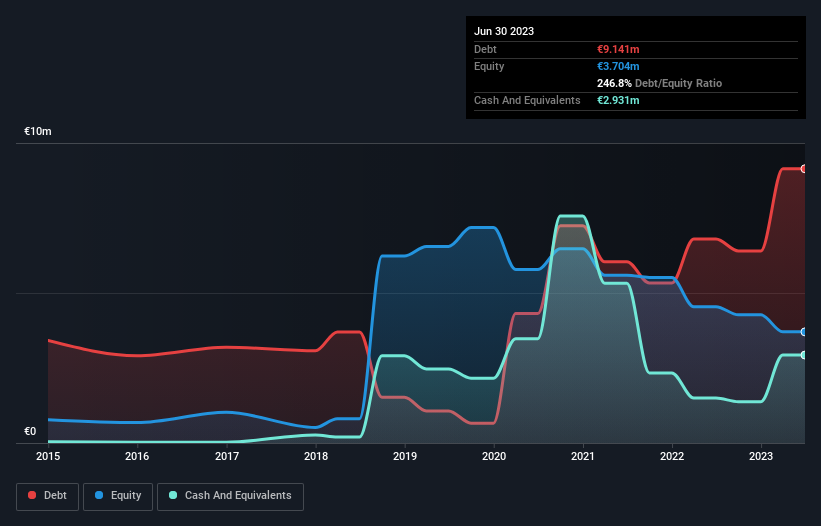Legendary fund manager Li Lu (who Charlie Munger backed) once said, 'The biggest investment risk is not the volatility of prices, but whether you will suffer a permanent loss of capital.' So it might be obvious that you need to consider debt, when you think about how risky any given stock is, because too much debt can sink a company. We can see that Longino & Cardenal S.p.A. (BIT:LON) does use debt in its business. But should shareholders be worried about its use of debt?
Why Does Debt Bring Risk?
Generally speaking, debt only becomes a real problem when a company can't easily pay it off, either by raising capital or with its own cash flow. In the worst case scenario, a company can go bankrupt if it cannot pay its creditors. However, a more usual (but still expensive) situation is where a company must dilute shareholders at a cheap share price simply to get debt under control. By replacing dilution, though, debt can be an extremely good tool for businesses that need capital to invest in growth at high rates of return. When we examine debt levels, we first consider both cash and debt levels, together.
See our latest analysis for Longino & Cardenal
What Is Longino & Cardenal's Net Debt?
You can click the graphic below for the historical numbers, but it shows that as of June 2023 Longino & Cardenal had €9.14m of debt, an increase on €6.80m, over one year. However, it does have €2.93m in cash offsetting this, leading to net debt of about €6.21m.

How Strong Is Longino & Cardenal's Balance Sheet?
According to the last reported balance sheet, Longino & Cardenal had liabilities of €11.4m due within 12 months, and liabilities of €6.05m due beyond 12 months. Offsetting these obligations, it had cash of €2.93m as well as receivables valued at €8.49m due within 12 months. So it has liabilities totalling €6.02m more than its cash and near-term receivables, combined.
While this might seem like a lot, it is not so bad since Longino & Cardenal has a market capitalization of €13.1m, and so it could probably strengthen its balance sheet by raising capital if it needed to. However, it is still worthwhile taking a close look at its ability to pay off debt. When analysing debt levels, the balance sheet is the obvious place to start. But it is future earnings, more than anything, that will determine Longino & Cardenal's ability to maintain a healthy balance sheet going forward. So if you want to see what the professionals think, you might find this free report on analyst profit forecasts to be interesting.
Over 12 months, Longino & Cardenal reported revenue of €35m, which is a gain of 8.3%, although it did not report any earnings before interest and tax. We usually like to see faster growth from unprofitable companies, but each to their own.
Caveat Emptor
Importantly, Longino & Cardenal had an earnings before interest and tax (EBIT) loss over the last year. Indeed, it lost €534k at the EBIT level. When we look at that and recall the liabilities on its balance sheet, relative to cash, it seems unwise to us for the company to have any debt. Quite frankly we think the balance sheet is far from match-fit, although it could be improved with time. However, it doesn't help that it burned through €812k of cash over the last year. So in short it's a really risky stock. The balance sheet is clearly the area to focus on when you are analysing debt. But ultimately, every company can contain risks that exist outside of the balance sheet. We've identified 1 warning sign with Longino & Cardenal , and understanding them should be part of your investment process.
When all is said and done, sometimes its easier to focus on companies that don't even need debt. Readers can access a list of growth stocks with zero net debt 100% free, right now.
New: AI Stock Screener & Alerts
Our new AI Stock Screener scans the market every day to uncover opportunities.
• Dividend Powerhouses (3%+ Yield)
• Undervalued Small Caps with Insider Buying
• High growth Tech and AI Companies
Or build your own from over 50 metrics.
Have feedback on this article? Concerned about the content? Get in touch with us directly. Alternatively, email editorial-team (at) simplywallst.com.
This article by Simply Wall St is general in nature. We provide commentary based on historical data and analyst forecasts only using an unbiased methodology and our articles are not intended to be financial advice. It does not constitute a recommendation to buy or sell any stock, and does not take account of your objectives, or your financial situation. We aim to bring you long-term focused analysis driven by fundamental data. Note that our analysis may not factor in the latest price-sensitive company announcements or qualitative material. Simply Wall St has no position in any stocks mentioned.
About BIT:LON
Longino & Cardenal
Provides catering services to the hotel, restaurant, catering, and gastronomy sectors in Italy, rest of the European Union, and internationally.
Undervalued with adequate balance sheet.
Market Insights
Community Narratives



